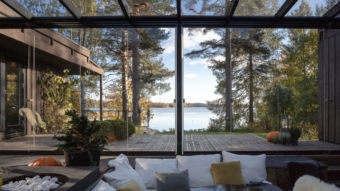At Lumon, we understand the importance of balancing progress with preserving our natural ecosystems. With recent updates in biodiversity net gain (BNG) regulations in the UK, it’s crucial for developers to stay informed and adapt our practices accordingly.

-
How to Decorate Your Outdoor Space
Read more…Decorating your space can transform it into a relaxing oasis, perfect for unwinding after a long day or entertaining guests. With the right decor, your patio, balcony, or garden can become an extension of your home, providing a seamless blend between indoor and outdoor living. Let’s dive into the best ways to decorate your outdoor space, ensuring it’s stylish and functional.
-
Bringing Sunshine Indoors: Creative Ways to Brighten Up Your Home
Read more…When it comes to creating a welcoming and uplifting atmosphere in your home, nothing quite beats the warm, radiant glow of natural sunlight. Sunlight brightens your space and has numerous psychological benefits, including boosting mood, increasing productivity, and reducing stress.
-
Inspiring Garden Makeover Ideas In 2023
Read more…As we step into the year 2023, the world of garden makeovers is witnessing exciting new garden trends and innovative ideas that promise to redefine outdoor living spaces. A well-designed garden can be a retreat from the hustle and bustle of daily life, providing a serene and visually appealing environment for relaxation, entertainment, and enjoyment.
Understanding Biodiversity Net Gain
Biodiversity net gain (BNG) is an approach to development mandated from 12 February 2024. It ensures that natural habitats used for wildlife are left in a measurably better state than they were before the development. Developers must deliver a BNG of 10%, resulting in more or better quality natural habitat than before development.
The Regulatory Landscape
The UK government’s amendments to the Environment Act now make BNG mandatory for certain projects seeking planning permission. This significant update underscores the country’s commitment to sustainable development practices. Developers are now required to demonstrate how they will deliver a measurable increase in biodiversity on or off-site.
Key Components of Biodiversity Net Gain
Biodiversity units are central to the concept of BNG, quantifying the biodiversity value of habitats. These units can be lost through development or generated through work to create and enhance habitats. Measuring biodiversity value requires consultation with an ecologist, who assesses the biodiversity baseline of the existing habitat and advises on suitable habitat creation or enhancement.
Calculating Biodiversity Units
A statutory biodiversity metric is used to calculate the number of biodiversity units for existing habitats or enhancements required to achieve BNG. This official metric tool applies a formula to determine the biodiversity value of habitats before and after development.
Ways to Achieve BNG
Developers have three options to achieve BNG: on-site units, off-site units, and statutory biodiversity credits. The biodiversity gain hierarchy dictates the order in which these options should be pursued. Off-site units or statutory biodiversity credits should be a last resort, with developers prioritising on-site and off-site gains where possible.
Maintaining Habitats
Developers and land managers have a legal responsibility to create, enhance, and maintain habitats for at least 30 years to achieve the target condition. This includes maintaining habitats created or enhanced on-site or off-site.
Planning Permission and Biodiversity Gain Plans
When applying for planning permission, developers must confirm whether their development is exempt from mandatory BNG. If not exempt, they must provide information on how they intend to meet BNG objectives, including details of proposed significant on-site enhancements. A biodiversity gain plan must be submitted to the local planning authority for approval before development can commence.
Responsibilities of Land Managers
Land managers, including landowners and developers, play a crucial role in delivering BNG. Selling off-site biodiversity units on the BNG market is an option for land managers, providing a potential source of revenue for nature recovery work on their land.
Recording Biodiversity Gains
Land managers must sign a legal agreement with a responsible body or local planning authority, setting out how they will create, enhance, maintain, and monitor biodiversity in registered units. Before selling units, land managers must register their land as a biodiversity gain site and record the allocation of units to developments.
Work With Lumon For Your Future Developments
Biodiversity net gain represents a fundamental shift towards sustainable development practices in the UK. It is the developer’s responsibility to embrace this concept and ensure that projects contribute positively to the natural environment.
At Lumon, we’re committed to integrating biodiversity considerations into all our development projects, working collaboratively with stakeholders to achieve measurable increases in biodiversity. Together, we can create a future where development and biodiversity conservation go hand in hand, preserving our ecosystems for generations to come.
If you’re a developer or land manager looking to navigate BNG requirements effectively, get in touch with us today. Let’s work together towards a greener, more sustainable future.

